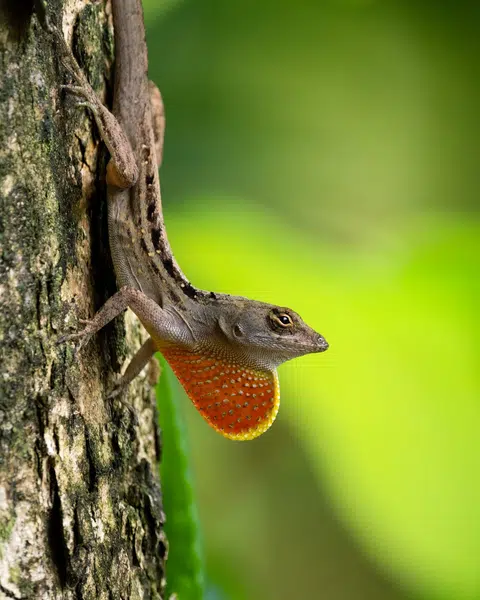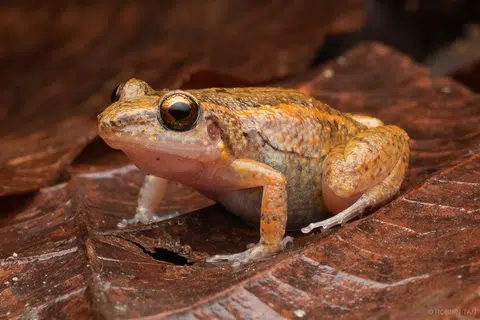NParks investigates threat of brown anoles, greenhouse frogs to native species
In many areas across Singapore, one may find small, slender lizards - sometimes displaying a yellow or reddish orange flap under its throat - if they look intently enough.
These lizards, which can be found on the ground or trees, are called brown anoles (Anolis sagrei), and they have been spotted at an increasing frequency across the island. The catch is: they are not supposed to be here.
Brown anoles are found naturally in the Bahamas, Cuba and the Swan Islands.
It is one of two introduced species, the other being the greenhouse frog (Eleutherodactylus planirostris), that have been seen here more often, and in more places.
The greenhouse frog is native to the Bahamas, Cuba and the Cayman Islands.
For instance, two brown anoles were spotted in the balcony of a residential unit in Sembawang in March.
Introduced species refer to plants or animals that are not naturally found in Singapore.
They can be considered invasive when their presence causes harmful impacts on the local environment. This could happen if, for instance, they outcompete native species due to a lack of natural predators, high reproductive rates, and adaptability to different environmental conditions.
The National Parks Board (NParks) told The Straits Times that it is aware of the presence of the brown anole and greenhouse frog in Singapore and that it is monitoring the situation.
Dr Karenne Tun, group director for NParks' National Biodiversity Centre, said the brown anole has outcompeted the native green anole in Florida, and in Taiwan, it has impacted local arthropod (animals including insects) communities in betelnut palm plantations. In Hawaii and other parts of the US, the greenhouse frog has also been documented as invasive, she added.
However, there is no evidence that these species have significantly impacted local ecosystems so far, she added.
Observers believe the two Caribbean species came into Singapore by "piggy-backing" on exotic plants that were brought in by the horticultural sector.

Dr Alex Figueroa, executive secretary of the International Commission on Zoological Nomenclature based at Lee Kong Chian Natural History Museum at NUS, said brown anoles continue to be introduced throughout the island, on plants imported by nurseries.
"At this moment, brown anoles do not appear to be invasive in Singapore," said the reptile and amphibian researcher.
He said that most of the lizards found here are bigger than the brown anole, which is usually about 12 to 21cm long, and either live on the ground or high in the trees. Meanwhile, brown anoles prefer warm, open grassy areas and the lower parts of trees and shrubs.
Brown anoles were observed and recorded in Singapore for the first time in 2012 when they were sighted at Gardens by the Bay, according to the report by Nature in Singapore, an online journal of the Lee Kong Chian Natural History Museum.
"The many individuals, hatchlings, and courtship activities observed at the Gardens by the Bay strongly suggest that the brown anole has already established a population in Singapore, at least within Marina Bay," wrote the report, adding that it is the first reptile from the Americas that has done so there.

Years later, they continue to be spotted in different parts across the island such as in Bishan in 2015, Jurong Lake Gardens in 2020 and Choa Chu Kang in 2022.
When ST visited Gardens by the Bay in March, a brown anole was spotted perched on a tree trunk near the Bayfront MRT station. Subsequently, 11 more were spotted in less than 1.5 hours.
As for the greenhouse frog, the first sighting of the small amphibian - its length ranges from about 12mm to 30mm - was recorded in Sembawang in 2015. These creatures were also spotted in Clementi Woods and Dairy Farm Nature Park in 2017.
While a population study has yet to be done on the greenhouse frog in Singapore, Mr Robbin Tan, a scientific officer at the Herpetological Society of Singapore (HSS), said: "Today, the greenhouse frog is widespread across Singapore, including within our Central Catchment Nature Reserve… We can ascertain that there are plenty of breeding populations established in Singapore."
Mr Tan said the greenhouse frog has successfully established populations throughout Hawaii, Hong Kong and the Philippines. Its global spread has been primarily driven by the plant trade, he added.
Dr Figueroa said while it is hard to estimate their population without properly studying the frog, it is "safe to say" that they can be found throughout Singapore, and in some areas, they can be found in large numbers, although this is difficult to tell given how tiny they are.
While the frog can be found widely across Singapore, it remains to be seen if they are harmful to other native species due to the lack of evidence, experts said.
However, Associate Professor Darren Yeo, head of the Lee Kong Chian Natural History Museum at NUS, said they may be considered potentially invasive as they are already widespread in Singapore, and can spread rapidly.
Greenhouse frogs skip the tadpole stage entirely and their eggs develop into frogs. This also means that unlike other frogs, they do not need water bodies to breed, which enhances their ability to spread, he said.

HSS' Mr Tan added that due to its small size, habitat and diet, the greenhouse frog may also compete with native chorus frog species, especially since both can be found in similar places, like secondary forests and leaf litter.
Ms Tricia Cho, a research assistant at Lee Kong Chian Natural History Museum at NUS who has done research on greenhouse frogs, said more research and monitoring could be done to assess their population status and quantify any negative effects they might bring to the local ecosystem.
HSS' Mr Tan said that public education campaigns and citizen science programs encourage people to report sightings, avoid releasing non-native pets, and support conservation efforts. Besides regular monitoring and early detection, he said that restoring native habitats and reducing human disturbances strengthen ecosystem resilience, making it harder for non-native and invasive species to establish.
Prof Yeo said that most invasive and non-native species in Singapore tend to be found in more urban or artificial habitat areas and less in more forested and natural habitat areas.
"This could reflect a preference for urban or artificial systems or a resistance by the native communities in natural systems," he said. "If it's the latter, we can help prevent invasive species from affecting the ecosystems by keeping as much of the ecosystems and their faunal and floral communities as intact as possible."
Chin Hui Shan for The Straits Times